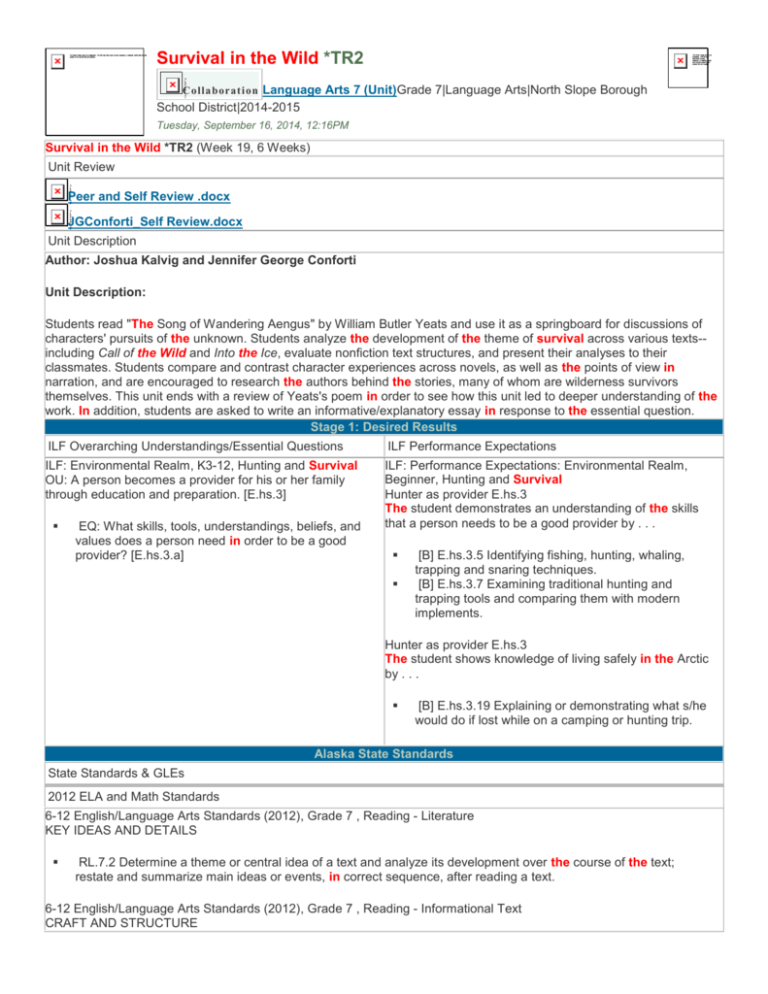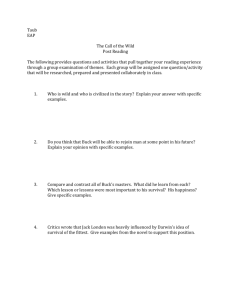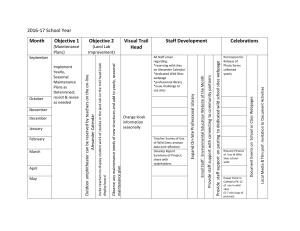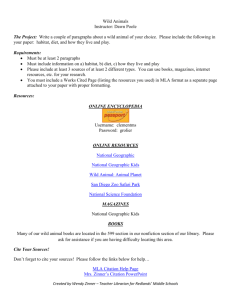
Survival in the Wild *TR2
Col la borat i on Language Arts 7 (Unit)Grade 7|Language Arts|North Slope Borough
School District|2014-2015
Tuesday, September 16, 2014, 12:16PM
Survival in the Wild *TR2 (Week 19, 6 Weeks)
Unit Review
Peer and Self Review .docx
JGConforti_Self Review.docx
Unit Description
Author: Joshua Kalvig and Jennifer George Conforti
Unit Description:
Students read "The Song of Wandering Aengus" by William Butler Yeats and use it as a springboard for discussions of
characters' pursuits of the unknown. Students analyze the development of the theme of survival across various texts-including Call of the Wild and Into the Ice, evaluate nonfiction text structures, and present their analyses to their
classmates. Students compare and contrast character experiences across novels, as well as the points of view in
narration, and are encouraged to research the authors behind the stories, many of whom are wilderness survivors
themselves. This unit ends with a review of Yeats's poem in order to see how this unit led to deeper understanding of the
work. In addition, students are asked to write an informative/explanatory essay in response to the essential question.
Stage 1: Desired Results
ILF Overarching Understandings/Essential Questions
ILF Performance Expectations
ILF: Environmental Realm, K3-12, Hunting and Survival
OU: A person becomes a provider for his or her family
through education and preparation. [E.hs.3]
ILF: Performance Expectations: Environmental Realm,
Beginner, Hunting and Survival
Hunter as provider E.hs.3
The student demonstrates an understanding of the skills
that a person needs to be a good provider by . . .
EQ: What skills, tools, understandings, beliefs, and
values does a person need in order to be a good
provider? [E.hs.3.a]
[B] E.hs.3.5 Identifying fishing, hunting, whaling,
trapping and snaring techniques.
[B] E.hs.3.7 Examining traditional hunting and
trapping tools and comparing them with modern
implements.
Hunter as provider E.hs.3
The student shows knowledge of living safely in the Arctic
by . . .
[B] E.hs.3.19 Explaining or demonstrating what s/he
would do if lost while on a camping or hunting trip.
Alaska State Standards
State Standards & GLEs
2012 ELA and Math Standards
6-12 English/Language Arts Standards (2012), Grade 7 , Reading - Literature
KEY IDEAS AND DETAILS
RL.7.2 Determine a theme or central idea of a text and analyze its development over the course of the text;
restate and summarize main ideas or events, in correct sequence, after reading a text.
6-12 English/Language Arts Standards (2012), Grade 7 , Reading - Informational Text
CRAFT AND STRUCTURE
RI.7.5 Analyze the structure an author uses to organize a text, including how the major sections contribute to the
whole and to the development of the ideas.
6-12 English/Language Arts Standards (2012), Grade 7 , Writing
TEXT TYPES AND PURPOSES
W.7.1.a-e Write arguments to support claims with clear reasons and relevant evidence.
6-12 English/Language Arts Standards (2012), Grade 7 , Speaking and Listening
PRESENTATION OF KNOWLEDGE AND IDEAS
SL.7.4 Present claims and findings, emphasizing salient points in a focused, coherent manner with pertinent
descriptions, facts, details, and examples; use appropriate eye contact, adequate volume, and clear
pronunciation.
6-12 English/Language Arts Standards (2012), Grade 7 , Language
VOCABULARY ACQUISITION AND USE
L.7.5.a-c Demonstrate understanding of figurative language, word relationships, and nuances in word meanings.
Content Area Understandings & Essential Questions
Content Area OUs & EQs
Topical Understandings & Essential Questions
NSBSD: Language Arts, K3-12, Language Arts
NSLA.4 OU: Effective readers are able to identify a text
structure and use appropriate strategies to analyze and
comprehend the text.
OU: Survival is a basic, human instinct.
NSLA.4.a EQ: What might effective readers do
when trying to understand different types of text?
NSLA.4.b EQ: When do we have enough
information to draw conclusions?
NSLA.4.c EQ: How do readers isolate essential
information in a text?
NSLA.6 OU: Writing is a process for clarifying as well as
expressing one's idea to convey a message to target
audiences.
NSLA.6.b EQ: What is my purpose for writing?
NSLA.6.c EQ: What makes an argument effective?
NSLA.6.d EQ: What role does writing play in our
lives and culture?
NSLA.9 OU: Effective researchers evaluate the credibility
and accuracy of information and honor the work of other
researchers.
NSLA.9.a EQ: What does it mean to be credible?
NSLA.11 OU: Effective listening and speaking requires
responding thoughtfully to diverse perspectives; following
rules for collegial discussions (i.e. taking turns,
paraphrasing); and adapting speech to a variety of contexts.
NSLA.11.f EQ: What makes an argument effective?
NSLA.12 OU: Technology is a tool that enhances the way
EQ: What similarities and differences exist among
characters who survive in the wilderness?
EQ: What are the basic needs that one will need in order to
survive in extreme conditions?
EQ: What sacrifices must be made in order to survive?
we communicate.
NSLA.12.b EQ: How do learners determine the
strengths and limitations of technological tools in
order to determine those best suited to their
communication goals?
Knowledge
Student will know...
the similarities and differences between characters
from different pieces of writing.
the central theme and topic of different genres.
research strategies and techniques.
the skills and strategies needed to survive.
Skills
Students will be able to...
analyze the development of characters and themes
in texts about survival.
discuss how the authors' use of literary techniques
in narration, such flashback and point of view,
engage the reader.
conduct research on authors who write about
survival in the wild and present findings to the
class.
take comprehensible notes on important content,
ideas, and details in texts (e.g., about character
development).
write a survival-in-the-wild story using figurative
language and exploiting nuances in word meaning
for effect.
Stage 2: Assessment Evidence
Transfer Task(s) (Performance Assessments)
At least one assessment in GRASPS form.
Survival Brochure (DOK 3)
Summative: Performance (GRASPS)
Top of the World Hotel, in Barrow, Alaska, has asked you to create a tri-fold, color brochure for its tour company. Your
audience are adventure travelers who have come to the North Slope to experience the Arctic environment. Your brochure
will focus on survival techniques specific to the North Slope climate, wildlife, landscape, etc. To increase your
knowledge, you will research several websites before beginning to create your brochure.
Your brochure should include the following:
A front title page with a picture and slogan
A Works Cited page on the back
Visually interesting graphics (photos, maps, data charts, etc.)
Bold headlines to introduce information
5 general rules about surviving in the Arctic
3 additional topics from the choices below
Edible plants/poisonous plants
First aid tips
Dealing with wild animals
Building a shelter
Surviving inclement weather
Finding food and water
Survival Brochure Rubric.docx
Survival Brochure Assignment.docx
Evaluative Criteria
Other Evidence (Graded)
Survival Brochure Rubric - See link below.
Active Reading Chapter 1-3.pdf
Active Reading Chapter 4-5.pdf
Survival Brochure Rubric.docx
Active Reading Chapter 6-7.pdf
Before Reading Chapter 1-3.pdf
Before Reading Chapter 4-5.pdf
Before Reading Chapter 6-7.pdf
Call of the Wild - End of Book Activities.png
Stage 3: Learning Plan
Learning Experiences (in order of implementation)
1. Activity 1: "The Song of Wandering Aengus" by
William Butler Yeats
Description: Read, "The Song of Wandering
Aengus" by William Butler Yeats. Students
will talk with a classmate on what they
thought the poem means, both literally and
figuratively.
Compile the students' ideas on the
SmartBoard T-Chart and save them for the
end of this unit.
(Note: The last activity of this Unit
will be to revisit this poem and find
out if the students' thought and
ideas have changed.) Rec
See link below, The Song of Wandering
Aengus.
See link below, The Song of Wandering
Aengus T-Chart.
2. Activity 2: Introduce the Author of The Call of
the Wild, Jack London
Introduce the author Jack London to the
students.
See link below for information on Jack
London - "Introduction to Jack London"
3. Activity 3: Introduce the novel, The Call of the
Wild.
Introduce the novel to the students
emphasizing the key concepts and terms
they will need to know before reading the
novel.
See link below for an introduction to The
Call of the Wild - "Introduction to Call of the
Wild"
4. Activity 3: "The Call of the Wild" by Jack London
Pre-reading Activity - Jack London writes
about his main character Buck as if he were
a person. This literary technique is called
"anthropomorphism," or giving human
qualities to nonhumans. By using
anthropomorphism, London helps readers
identify with Buck.
Write a journal entry about pets or animals
you have known that behave almost as if
they were people. Detail events and
expressions that helped you discover what
that animal was thinking.
5. Activity 4: Chapter 1 - 3 of "The Call of the Wild"
Checking for Understanding (Ungraded)
1. Checking for Understanding linked to the first
learning experience (Activity 1). Students will
express their thoughts of what the poem, "The Song
of Wandering Aengus" means and the teacher will
record these thoughts on the T-Chart.
See link below, The Song of Wandering
Aengus T-Chart.
2. Checking for Understanding linked to the fourth
learning experience (Activity 3). Students will
discuss complete the pre-reading activity write in
their journals.
3. Checking for Understanding linked to the fifth
learning experience (Activity 4). Students will
discuss Chapters 1-3 of "The Call of the Wild."
See link below - Call of the Wild - Chapter 1
Discussion
See link below - Call of the Wild - Chapter 2
Discussion
See link below - Call of the Wild - Chapter 3
Discussion
4. Checking for Understanding linked to the sixth
learning experience (Activity 5). Students will
discuss Chapters 4-5 of "The Call of the Wild.
See link below - Call of the Wild - Chapter 4
Discussion
See link below - Call of the Wild - Chapter 5
Discussion
5. Checking for Understanding linked to the seventh
learning experience (Activity 6). Students will
discuss Chapters 6-7 of "The Call of the Wild.
See link below - Call of the Wild - Chapter 6
Discussion
See link below - Call of the Wild - Chapter 7
Discussion
6. Check for Understanding linked to the ninth learning
experience (Final Activity). Students will re-read the
poem, "The Song of Wandering Aengus" and fill in
the After Reading section of the T-Chart.
See link below - The Song of Wandering
Aengus
See link below - The Song of Wandering
Aengus T-Chart
The Song of Wandering Aengus T-Chart.notebook
Call of the Wild - Chapter 1 Discussion.png
by Jack London
Complete the Before Reading Chapter 1-3
Activity
See Link Below Entitled - "Before
Reading Chapter 1-3"
As you read Chapter 1-3 you may ask
several discussion questions. This primarily
used to encourage students to think about
what they are reading and to check for
understanding. Please refer to the
discussion questions provided for chapters
1-3.
See Link Below Entitled - "Call of
the Wild - Chapter 1 Discussion"
See Link Below Entitled - "Call of
the Wild - Chapter 2 Discussion"
See Link Below Entitled - "Call of
the Wild - Chapter 3 Discussion"
As students finish reading Chapters 1-3,
have them complete the Active Reading
documents that accompany these chapters.
These documents will allow the students to
demonstrate their understanding of the
novel.
See Link Below Entitled - "Active
Reading - Chapter 1-3"
Note: You have the option of reading the
book to your students or having them listen
to the book from SAFARI Montage.
See link below for eBook entitled, The Call
of the Wild eBook.
6. Activity 5: Chapter 4 - 5 of "The Call of the Wild"
by Jack London
Complete the Before Reading Chapter 4 - 5
Activity
See Link Below Entitled - "Before
Reading Chapter 4-5"
As you read Chapter 4 - 5 you may ask
several discussion questions. This primarily
used to encourage students to think about
what they are reading and to check for
understanding. Please refer to the
discussion questions provided for chapters
4 - 5.
See Link Below Entitled - "Call of
the Wild - Chapter 4 Discussion"
See Link Below Entitled - "Call of
the Wild - Chapter 5 Discussion"
As students finish reading Chapters 1-3,
have them complete the Active Reading
documents that accompany these chapters.
These documents will allow the students to
demonstrate their understanding of the
novel.
See Link Below Entitled - "Active
Reading - Chapter 1-3"
7. Activity 6: Chapter 6 - 7 of "The Call of the Wild"
by Jack London
Complete the Before Reading Chapter 6 - 7
Activity
See Link Below Entitled - "Before
Reading Chapter 6 - 7"
Call of the Wild - Chapter 2 Discussion.png
Call of the Wild - Chapter 3 Discussion.png
Call of the Wild - Chapter 4 Discussion.png
Call of the Wild - Chapter 5 Discussion.png
Call of the Wild - Chapter 6 Discussion.png
Call fo the Wild - Chapter 7 Discussion.png
As you read Chapter 6 - 7 you may ask
several discussion questions. This primarily
used to encourage students to think about
what they are reading and to check for
understanding. Please refer to the
discussion questions provided for chapters
6 - 7.
See Link Below Entitled - "Call of
the Wild - Chapter 6 Discussion"
See Link Below Entitled - "Call of
the Wild - Chapter 7 Discussion"
As students finish reading Chapters 1-3,
have them complete the Active Reading
documents that accompany these chapters.
These documents will allow the students to
demonstrate their understanding of the
novel.
See Link Below Entitled - "Active
Reading - Chapter 6 - 7"
8. Activity 7 - Finishing "The Call of the Wild" by
Jack London
As a culminating activity, you may choose
from one of the final activities.
See link below entitled, "Call of the
Wild - End of Book Activities."
9. Final Activity
Re-read the poem, "The Song of Wandering
Aengus." After the Unit has been
completed, have students describe how
their understanding of the poem has
changed.
Ask them, "What new insights have you
gained?" Add these insights to the
document you created in Activity 1 (in a
new column next to your initial thoughts).
Discuss with the class how this poem
relates to the theme of this unit (survival in
the wild).
See link below - The Song of Wandering
Aengus
See link below - The Song of Wandering
Aengus T-Chart
10. Optional Activity: Read the nonfiction book,
"Into the Ice: The Story of Arctic Exploration" by
Lynn Curlee.
As you read "Into the Ice: The Story of
Arctic Exploration," discuss the theme of
survival.
Emphasize to the students that this book is
nonfiction and the accounts and information
are true.
Display the map of the Arctic Circle and
point out the North Slope in comparison to
the North Pole.
The purpose of this book is not only to
discuss the topic of survival, but to make a
connection to the North Slope and the other
unique locations in the Arctic Circle.
The Song of Wandering Aengus.pdf
The Song of Wandering Aengus T-Chart.notebook
Introduction to Jack London.pdf
Introduction to Call of the Wild.pdf
The Call of the Wild eBook
Before Reading Chapter 1-3.pdf
Active Reading Chapter 1-3.pdf
Call of the Wild - Chapter 1 Discussion.png
Call of the Wild - Chapter 2 Discussion.png
Call of the Wild - Chapter 3 Discussion.png
Before Reading Chapter 4-5.pdf
Active Reading Chapter 4-5.pdf
Call of the Wild - Chapter 4 Discussion.png
Call of the Wild - Chapter 5 Discussion.png
Before Reading Chapter 6-7.pdf
Active Reading Chapter 6-7.pdf
Call of the Wild - Chapter 6 Discussion.png
Call fo the Wild - Chapter 7 Discussion.png
Call of the Wild - End of Book Activities.png
Resources and Preparation Materials
Active Reading Chapter 1-3.pdf
Active Reading Chapter 4-5.pdf
Active Reading Chapter 6-7.pdf
Before Reading Chapter 1-3.pdf
Before Reading Chapter 4-5.pdf
Before Reading Chapter 6-7.pdf
Call fo the Wild - Chapter 7 Discussion.png
Call of the Wild - Chapter 1 Discussion.png
Call of the Wild - Chapter 2 Discussion.png
Call of the Wild - Chapter 3 Discussion.png
Call of the Wild - Chapter 4 Discussion.png
Call of the Wild - Chapter 5 Discussion.png
Call of the Wild - Chapter 6 Discussion.png
Call of the Wild - End of Book Activities.png
Call of the Wild - Study Guide+.pdf
Introduction to Call of the Wild.pdf
Introduction to Jack London.pdf
Response to Call of the Wild.pdf
The Call of the Wild - Study Guide.pdf
The Call of the Wild - Text Study.pdf
The Song of Wandering Aengus.pdf
The Song of Wandering Aengus T-Chart.notebook
Student Evidence
The Song of Wandering Aengus by, William Yeats
©
<< Previous Year
Last Updated: Wednesday, August 6, 2014, 9:38AM
Atlas Version 8.0.4
© Rubicon International 2014. All rights reserved






